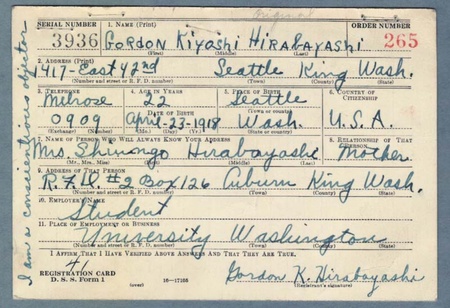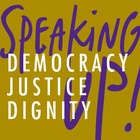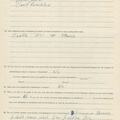Read Part 1 >>
Records of the United States District Courts, Record Group 21
NARA field facilities hold federal district and bankruptcy court case files heard in the courts in their geographic area. Some may also hold cases from a federal Circuit Court of Appeals if an appeals court exists nearby. The case files typically include all of the filings in the case, but frequently not the exhibits or transcripts. Exhibits are often returned to the person submitting them or are destroyed. Transcripts were not created unless requested or the case was appealed.
When a court decision is appealed portions of the case may be found in multiple NARA facilities. District court cases heard in the West are typically appealed to the Ninth Circuit Court of Appeals. The Circuit Court sits in San Francisco and their case files are stored at the National Archives in San Francisco. Cases appealed to the U.S. Supreme Court are stored at the National Archives at Washington D.C. For example, to track a case appealed from the Portland federal District Court may require contacting the NARA offices in Seattle, San Francisco, and Washington DC.
The most significant cases involving individuals of Japanese descent during World War II at the National Archives at Seattle include the Minoru Yasui criminal case and three cases involving Gordon Hirabayashi. The first Hirabayashi case and the Yasui case are criminal matters regarding curfew violation. The Notice of Appeal in the Hirabayashi case file reads, in part,
Court I of the indictment…in that the defendant-appellant [Gordon Kiyoshi Hirabayashi] as a person of Japanese ancestry on May 11, 1942, and May 12, 1942, knowingly remained in Military Area No. 1, as such area is defined by Public Proclamations Nos. 1 and 2, issued by J.L. DeWitt as Lt. Gen., U.S. Army as the Military Commander of the Western Defense Command…
Court II of the indictment…in that defendant as a person of Japanese ancestry, but a native born American citizen, knowingly remained away from and not within his place of residence at Seattle, Washington on May 4, 1942, between the hours of 8:00 o’clock P.M. and 6:00 o’clock A.M. of May 5, 1942, which period is referred to as the hours of curfew.
Hirabayashi was found guilty, as was Yasui. In the Yasui case, Judge James Fee wrote a thirty-page opinion. Writing about Yasui, born in Hood River, Oregon, Judge Fee stated, “The only question now for the court to determine is as to whether Yasui, the defendant, is a citizen or an enemy alien…” The Yasui and the Hirabayashi cases were appealed. The Seattle federal court also heard the criminal case of United States v. Hideo Saiki and at least eight others for curfew violations in April 1942. There are similar cases from the Tacoma federal court.1
The second Hirabayashi case was heard in the federal court in Spokane, and addressed Hirabayashi’s refusal to report for induction for military service. Hirabayashi was found guilty and sentenced to one year in prison.

Front of the draft registration card completed by Gordon Hirabayashi, October 16, 1940. Registration Cards, Records of the Washington State Headquarters, Records of the Selective Service System, Record Group 147, National Archives at Denver.
The third case file, Gordon K. Hirabayashi v. United States filed in 1983 as a petition for writ of error coram nobis, includes court filings, a copy of Personal Justice Denied, and a transcript of testimony. A filing from the case states, “The petition submitted in this case discloses a pattern of conduct by government prosecutors and agents calculated to assure Petitioners’ conviction and to gain approval of wartime actions. In manipulating Petitioners’ cases in this way, the prosecution abrogated its duty to the courts, the constitution and the defense.” The case led to reversal of the two earlier convictions.2
Mary Asaba Ventura filed a petition for writ of habeas corpus on April 13, 1942, in the Seattle federal court. She objected to restrictions on her freedom imposed by the curfew ordered by General DeWitt. Mary was a native-born citizen married to a Filipino. She was impacted by the curfew because her parents were Japanese immigrants.
Her attorney wrote, “The cause of said unlawful and arbitrary restraint upon and the prohibition of the library of petitioner is only and solely because she is of Japanese descent.” The file includes the judge’s oral opinion denying her request and noting “How many believe that if our enemies should manage to send a suicide squadron of parachutists to Puget Sound that the Enemy High Command would not hope for assistance from many such American-born Japanese?” A representative of the Wartime Civil Control Administration attended the hearing. The file also contains correspondence with the Western Defense Command.3
Other cases from the Seattle federal district court include criminal actions brought against Thomas Masuda, Edward Osawa, Charles Takahashi, and Kenji Ito for allegedly acting as agents of foreign government and exporting military materials. One of the case files includes a transcript and another a petition signed by many internees at the Minidoka Relocation Center, in southern Idaho, who volunteered for military service asking that Osawa and Takahashi be allowed to join them in the military.4
In the records of the Southern Division of the District Court of Idaho there is a series of some 40 criminal cases charging men held at the Minidoka Relocation Center with non-compliance with the Selective Training and Service Act. The defendant in the first case is Hitoshi Akutsu and his indictment is dated September 6, 1944. The presiding judge was Chase Clark. Clark elected to hear several of the cases simultaneously and in quick succession. All but one were found guilty and typically were sentenced to three years and three months in prison. Many were sent to McNeil Island Federal Penitentiary near Seattle.
Some of the case files include statements written by the defendants. Jim Akutsu argued that he was “imprisoned and under the force and duress of the armed forces of the United States, and that he was at the time said crime was alleged to have been committed in no reasonable sense, nor could he reasonably be expected to be subject to…‘military training’…and was not a member of a ‘free society.’”
Frank Hino argued, “I have lost all faith and trust in this country and so have applied for expatriation.”
George Kodama wrote, “If I were treated like an American I would be more than glad to serve in the armed forces.”
Another defendant stated, “If I had an opportunity, I would be willing to join the Japanese Army.”5
The National Archives at Seattle has begun an effort to identify all of their court records related to the removal and incarceration of persons of Japanese descent. The National Archives at Riverside, California, responsible for historical records of federal agencies in southern California; Arizona; and Clark County, Nevada, has carried out such a survey.
The staff there has prepared a draft 166-page guide to Records Relating to Japanese and Japanese Americans during the Second World War. Almost half of the document lists civil, criminal, and bankruptcy court cases and provides a summary of each case.
Cases include sedition, requests for writ of habeas corpus, violation of measures of the Selective Training and Service Act, efforts to regain lost American citizenship, failure to report a change of address, bankruptcies due to incarceration, failure to register as an alien, and condemnation of land on Terminal Island (near Long Beach, California).6
Eric Bittner, archivist at the National Archives at Denver, in his 2008 Discover Nikkei article, Records at the National Archives-Rocky Mountain Region Relating to the Japanese American Interment Experience, lists a number of similar court cases held at the National Archives at Denver. The National Archives at San Francisco holds district and circuit court cases including United States v. Korematsu, United States v. Endo, United States v. Hirabayashi, and other cases arising from the incarceration of Japanese Americans.
Records of the Bureau of Land Management, Record Group 49
As the federal government responded to the demand to transport and house over 100,000 Japanese Americans in 1942, a wide variety of federal agencies became involved in the planning efforts. From time to time, archivists find previously undiscovered files related to the government’s efforts while processing records or responding to reference inquires.
For example, recently a file was found with a few letters regarding the “relocation of evacuated aliens” in the range management records of the Bureau of Land Management. Bureau staff had attended a “relocation” planning meeting held in Salt Lake City in March, 1942. The letters discuss possible use of former Civilian Conservation Corps facilities as “Relocation Centers” and the hope that Japanese Americans might fill a need for agricultural labor in eastern Oregon.
One letter stated, “The general plan as outlined by Mr. [Milton] Eisenhower, Director of the War Relocation Authority, is to locate these people in large reception centers built to accommodate 5,000 to 10,000 people.” One writer ventured the proposed plan would “relieve the acute labor shortage in agricultural areas involved.”7
Records of the Bureau of Indian Affairs, Record Group 75
A file titled “War Relocation Authority” is stored with the records of the Irrigation District operations of the Portland Area Office of the Bureau of Indian Affairs. The file was created in early 1942 and contains meeting notes, telegrams, correspondence, newspaper clippings, reports, and related documents concerning plans for the establishment of “relocation centers” in the Southwest.
Staff of the Irrigation Office had attended planning meetings and created this working file. Someone drew a skull and cross bones on the file cover. The file focuses on the Colorado River War Relocation Project at Poston, Arizona. It includes a draft sketch of a camp layout and a “Suggested Reception Center for Evacuees” form completed proposing the Tule Lake area as a “relocation center.”8
The National Archives at Riverside holds similar records from the Phoenix Area Office and Pima Indian Agency.
Records of U.S. Army Corps of Engineers, Record Group 77
Even though the Minidoka Relocation Center was located in Idaho, there are almost no records at the National Archives at Seattle related to the Camp. Within the records of the U.S. Army Corps of Engineers there is a file containing their “Completion Report for Minidoka War Relocation Area” dated January 31, 1943. The report describes, in summary form, the number and size of buildings, utilities, land ownership, and history of construction. There are five pages of copies of photographs and maps and plans of the site.9
The Corps of Engineers also constructed an Assembly Center in Toppenish, Washington, near Yakima, that was never used. They documented the project with fifteen black and white photographs. The Corps adapted buildings, and constructed new buildings, at the fairgrounds at Puyallup, Washington, for an Assembly Center that came to be known as “Camp Harmony.” They took 127 black and white photographs of the project between March 30, 1942 and April 20th. The photographs are in negative format only.10
The National Archives at Riverside has a limited number of Army Corps of Engineers files with information about the Manzanar Relocation Center in eastern California and Gila River Relocation Center in southern Arizona.
Records of the Bureau of Prisons, Record Group 129

Click to enlarge. Prisoner intake form completed on arrival of Massanori Hirata at the McNeil Island Federal Penitentiary from the Tule Lake Relocation Center on June 2, 1944. Register of Prisoners Received, Box 11, McNeil Island Penitentiary, Records of the Bureau of Prisons, Record Group 129, National Archives at Seattle.
McNeil Island Penitentiary operated in Puget Sound as a federal prison from 1875 until 1981. From time to time this penitentiary also operated outlaying prison camps. An incomplete collection of records of the prison have survived and are held at the National Archives at Seattle. Among the surviving records, the most valuable are the Register of Prisoners Received, 1875-1951, and the inmate files and photographs from about 1875 to 1920.
The Register provides demographic information about the prison population. It typically records the name, place and date of birth, crime, sentence, arrival and departure date, physical characteristics, and other information about the inmate. For example, the Register of Prisoners Received lists Gordon Hirabayashi’s prison camp inmate number as 1400 and records that he arrived on December 28, 1944, following his conviction in the Spokane court, and was released September 4, 1945.
The Register also provides information about the incarceration of residents of “relocation centers.” On June 2, 1944, three men arrived from the Tule Lake Relocation Center convicted of illegal operation of a radio transmitter. Masao Mayekawa is listed as the first inmate arriving from the Heart Mountain Relocation Center. Like Hirabayashi, Mayekawa was convicted of violation of the Selective Service Act, and was received on July 10, 1944, with 30 other Heart Mountain internees. A number of additional internees arrived from the Minidoka Relocation Center in October, 1944.11
It is extremely unfortunate that all McNeil Island inmate files and photographs dating after about 1920 were destroyed. As a result there are no photos or files of World War II era Japanese American inmates. The destruction of records dated after 1920 was not uniformly carried out across Bureau of Prisons facilities nationwide. Other National Archives facilities have more recent files. Federal prison records are also held in the National Archives at Atlanta, San Francisco (Alcatraz), and Kansas City (Leavenworth).12
Other surviving McNeil Island records include photographs of the institution and camps and copies of The Island Lantern, the inmates’ monthly magazine. Henry Nobuo Hirabayashi arrived at the prison in October of 1944 from Minidoka.
By December he is listed in the magazine’s credits as associate editor.13
Notes:
1. Notice of Appeal, United States of America v. Gordon Kiyoshi Hirabayashi, Criminal case file #45738 & Criminal case files #45683, 45684, 45686, 45687, 45688, 45689, 45690 & 45691, Box 179, United States District Court, Western District of Washington, Northern Division, Seattle, & United States of America v. Minoru Yasui, Criminal case files #22771 & 22775, Civil and Criminal Case Files, U.S. District Court, District of Oregon, Portland, Boxes 714 & 715, RG 21, National Archives at Seattle.
2. United States of America v. Gordon Hirabayashi, Criminal case file #C-7729, Box 35, United States District Court, Eastern District of Washington, Spokane, and Gordon Hirabayashi v. United States of America, #C83-122V, Boxes 10 & 11, Western District of Washington, Northern Division, Seattle, RG 21, National Archives at Seattle. Unfortunately the coram nobis civil case file of Minoru v. United States of America, case file #83-CV-151, from the federal district court in Portland was not kept. The Circuit Court of Appeals case, Minoru v. U.S., #84-3730, as well as two Hirabayashi v. U.S. cases from the Circuit Court of Appeals, #86-3853 & 86-3887 are at the National Archives at San Francisco.
3. Civil case file, #498, Box 83, United States District Court, Western District of Washington, Northern Division, Seattle, RG 21, National Archives at Seattle.
4. Criminal case files, #45646, 45651 & 45652, Boxes 177-178, United States District Court, Western District of Washington, Northern Division, Seattle, RG 21, National Archives at Seattle.
5. Criminal case files, Boxes 89-91, United States District Court, Southern Division of the District of Idaho, RG 21, National Archives at Seattle.
6. Records Relating to the Japanese and Japan Americans During the Second World War, The National Archives at Riverside.
7. R-Cooperations, War Activities, Evacuations file, Range Management Cooperation, Accession 49-54KP64, Box 1, Records of the Bureau of Land Management, Record Group 49, National Archives at Seattle.
8. Project Case Files, Box 857, Irrigation District #5, 6 & 7, San Francisco, CA, Portland Area Office, Records of the Bureau of Indian Affairs, Records Group 75, National Archives at Seattle.
9. Construction Completion Reports, 1942-1951, Box 1, Portland District, Records of the U.S. Army Corps of Engineers, Record Group 77, National Archives at Seattle.
10. Civil Works Projects Photographs, Box 23 & Project Photographs, Negatives, Box 2, Seattle District, Records of the U.S. Army Corps of Engineers, Record Group 77.
11. Inmate Intake Register (Camp), Box 15, McNeil Island Penitentiary, Records of the U.S. Bureau of Prisons, Record Group 129, National Archives at Seattle.
12. Lists of records of federal inmates at other National Archives facilities can be found at these websites:
www.archives.gov/kansas-city/finding-aids/leavenworth-penitentiary,
www.archives.gov/san-francisco/finding-aids/alcatraz-alpha.html and
www.archives.gov/atlanta/finding-aids/atlanta-penitentiary.
13. The Island Lantern, Box 5, McNeil Island Penitentiary, Records of the U.S. Bureau of Prisons, Record Group 129, National Archives at Seattle.
* * *
* Ken House will be leading “Workshop and Research Opportunities in the National Archives Relating to the Japanese American Experience” a special off-site workshop that will be part of JANM’s National Conference, Speaking Up! Democracy, Justice, Dignity on July 4-7, 2013 in Seattle, Washington. For more information about the conference, including how to register, visit janm.org/conference2013.
© 2013 Ken House






